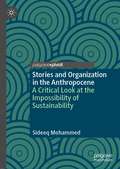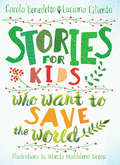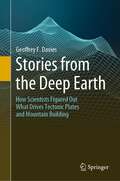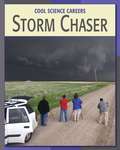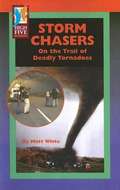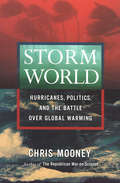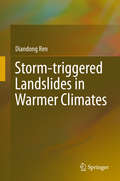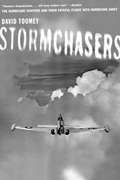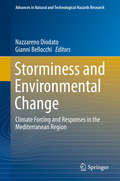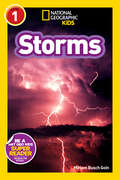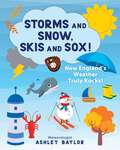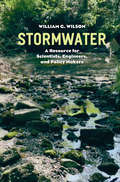- Table View
- List View
Stories and Organization in the Anthropocene: A Critical Look at the Impossibility of Sustainability
by Sideeq MohammedThis book is about the stories being told in the Anthropocene. Stories of irreparable damage being done to the global ecosystem, of sustainable growth, of dystopian collapse, of continued interspecies flourishing, of Gaia, and of accelerating capitalism’s dynamics in order to discover its outside. Stories of change. Stories of hope. Against them all, this book seeks to braid together a particular thread of storying in order to speak to the emergence of the mall at the end of the world; a space where a new politics of “spectral capitalism” is played out. In doing so, we reflect that there never was any outside to Capital, that it can live forever, its performances and spectacles being preserved despite global ecological collapse. This book seeks to understand the nascence of the mall at the end of the world and the new people, thoughts, and dreams that come with it.
Stories for Kids Who Want to Save the World
by Carola Benedetto Luciana CilientoSixteen biographies of extraordinary people--ranging from Sebastião Salgado to Björk and Greta Thunberg--who came of age fighting climate changeEvery person has a path in life, one that is intertwined with the fate of the earth. The life stories in this collection begin and end with that realization. First, as children, in different countries and eras, they witness how humans provoke environmental degradation. Each leads a life that not only minimizes their individual contribution to climate change at a local scale, but also that of their generation on a global scale. Then, as adults, they recognize the maturity and agency acquired at that moment which defined their lives. The biographies depict concrete initiatives that contribute to climate preservation, from a physicist who promotes organic farming techniques in India to a designer that only uses ecological fabrics and dyes in Italy. Rock climber Yvon Chouinard, biologist Rachel Carson, and designer Adriana Santanocito are included in this diverse cast of environmental activists. Together they show us that regardless of culture, class, or profession it is never too early or late to find your way to improve the world our children will inhabit. The stakes couldn't be higher: "Our house is on fire," as Greta Thunberg rightly said.
Stories from the Deep Earth: How Scientists Figured Out What Drives Tectonic Plates and Mountain Building
by Geoffrey F. DaviesPlate tectonics can drift continents and push up mountains, but what drives the plates? This is an insider’s account of how we answered questions posed over two centuries ago, and completed geology’s quest for a driving mechanism. Forging through confusing evidence, apparent contradictions and raging debates we arrived at not one but two mechanisms: sinking plates and rising plumes.
Stories of Change and Sustainability in the Arctic Regions: The Interdependence of Local and Global (Routledge Studies in Sustainability)
by Rita SørlyThis book presents stories of sustainability from communities in circumpolar regions as they grapple with environmental, economic and societal changes and challenges. Polar regions are changing rapidly. These changes will dramatically effect ecosystems, economy, people, communities and their interdependencies. Given this, the stories being told about lives and livelihood development are changing also. This book is the first of its kind to curate stories about opportunity and responsibility, tensions and contradictions, un/ethical action, resilience, adaptability and sustainability, all within the shifting geopolitics of the north. The book looks at change and sustainability through multidisciplinary and empirically based work, drawing on case studies from Norway, Sweden, Alaska, Canada, Finland and Northwest Russia, with a notable focus on indigenous peoples. Chapters touch on topics as wide ranging as reindeer herding, mental health, climate change, land-use conflicts and sustainable business. The volume asks whose voices are being heard, who benefits, how particular changes affect people’s sense of community and longstanding and cherished values plus livelihood practices and what are the environmental, economic and social impacts of contemporary and future oriented changes with regard to issues of sustainability? This volume will be of great interest to students and scholars of sustainability studies, sustainable development, environmental sociology, indigenous studies and environmental anthropology.
Stories of Human Resilience in a Changing Climate (Routledge Focus on Environment and Sustainability)
by Silvia Anna Ainio Susanna GionfraStories of Human Resilience in a Changing Climate offers a captivating glimpse into the human face of climate change.Despite extreme climate-related events witnessed globally, many struggle to connect such global phenomena to their own lives in a tangible way. As a result, there is still a strong disconnect between the general awareness of climate change and the sense of urgency that inspires action. This book fills a critical void in the field by sharing 11 real-life experiences across five continents of the world, featuring ordinary people facing and adapting to the consequences of climate change in its different forms. Through gripping accounts of a nomad having to relocate from the desert to the nearest city, an indigenous person fighting back for land rights, and a winemaker finding creative solutions to increasing heatwaves, among other stories, the book humanises the challenges of climate change. By weaving scientific data with personal stories, the chapters deliver a compelling call to move beyond mere acknowledgment of the problem towards transformative action that respects the balance of ecosystems, fosters sustainable practices, and redefines our relationship with nature. Overall, the book highlights the urgent need for global awareness on what ultimately represents one of the most pressing challenges of our time, leaving readers inspired and empowered to create a more sustainable and resilient future.This accessible and impactful book will be of great interest to students and scholars of climate change and environmental sciences and communication, as well as community leaders and NGOs wanting to understand practical examples and insights of climate change phenomena. Views and opinions expressed are those of the authors only and do not necessarily reflect those of the European Union or the European Commission.
Storm Chaser
by Mike Olbinski&“Olbinski chases storms . . . capturing lightning, tornadoes and dramatic cloud formations in images that convey the awesome power and beauty of nature.&” —International Business Times The storms that cross the Great Plains of North America each spring are some of nature&’s most spectacular. They can also be some of the most dangerous. Most people who live in areas susceptible to these storms keep a close eye on the weather reports and take cover or evacuate when one is on the way. Storm chasers keep an even closer eye on the weather data, but for a different reason: they don&’t run away when they see a storm approaching, they follow it! Professional photographer and Emmy Award winner, Mike Olbinski has chased storms throughout his native Arizona, as well as even further afield, including Texas, Oklahoma, Kansas, and Colorado. Whether he&’s photographing lightning, tornadoes or even cloud formations, his remarkable images are able to convey nature in its most dramatic and impressive forms. With over 100 stunning colour photographs, this book brings together some of Mike&’s most breathtaking images from the past five years as he describes his love of the open road and the thrill of capturing the perfect storm on film. &“These pictures are truly fascinating; they show just how small we are and how little control we have over the environment and that these storms can pack a wallop. For fans of weather and spectacular photos, this is the book for you.&” —San Francisco Book Review (5-star review) &“A striking series of breath-taking pictures of nature lashing out from apocalyptic skies.&” —Daily Mail Online
Storm Chaser (Cool Science Careers)
by Ann HeinrichsA group of storm chasers along the highway are filming a tornado as it rips its way across the landscape. Some storm chasers are ordinary people looking for a thrill, but many are meteorologists working to find out more about dangerous weather.
Storm Chasers: On the Trail of Deadly Tornadoes
by Matt WhiteExamines what a storm chaser is and how they track, observe, and document deadly weather, especially tornadoes, and discusses how severe weather develops and safety precautions to take in such storms.
Storm Kings: The Untold History of America's First Tornado Chasers
by Lee SandlinWith 16 pages of black-and-white illustrationsFrom the acclaimed author of Wicked River comes Storm Kings, a riveting tale of supercell tornadoes and the quirky, pioneering, weather-obsessed scientists whose discoveries created the science of modern meteorology. While tornadoes have occasionally been spotted elsewhere, only the central plains of North America have the perfect conditions for their creation. For the early settlers the sight of a funnel cloud was an unearthly event. They called it the "Storm King," and their descriptions bordered on the supernatural: it glowed green or red, it whistled or moaned or sang. In Storm Kings, Lee Sandlin explores America's fascination with and unique relationship to tornadoes. From Ben Franklin's early experiments to the "great storm war" of the nineteenth century to heartland life in the early twentieth century, Sandlin re-creates with vivid descriptions some of the most devastating storms in America's history, including the Tri-state Tornado of 1925 and the Peshtigo "fire tornado," whose deadly path of destruction was left encased in glass. Drawing on memoirs, letters, eyewitness testimonies, and archives, Sandlin brings to life the forgotten characters and scientists who changed a nation--including James Espy, America's first meteorologist, and Colonel John Park Finley, who helped place a network of weather "spotters" across the country. Along the way, Sandlin details the little-known but fascinating history of the National Weather Service, paints a vivid picture of the early Midwest, and shows how successive generations came to understand, and finally coexist with, the spiraling menace that could erase lives and whole towns in an instant.
Storm Surge Forecasting and Future Projection in Practice: Scope of Application of Empirical Typhoon Models
by Masaya Toyoda Nobuki FukuiThis accessible shortform book describes storm surge forecasting to enable port managers and practitioners to forecast these and mitigate their effects. This is particularly useful as global warming increases the severity of typhoons, particularly windstorms and storm surge disasters, globally.The authors first summarize the current status of typhoons and storm surges in practice. They also present a combination of the latest findings at the research level and at the practical level. Throughout the book, the authors carefully explain the use and limitations of empirical typhoon models that practitioners should learn from, including statistical, numerical, probabilistic, data-driven and coastal vulnerability models. They also explore artificial neural networks and convolutional neural networks and their use in such models. Finally, the book describes the potential for further development of empirical typhoon models (such as future climate experiments).This book is a vital resource that enables port managers to make effective and informed decisions when conducting storm surge forecasting in practice. It also contains useful insights for civil engineering students, especially those studying coastal engineering.
Storm Surge: Hurricane Sandy, Our Changing Climate, and Extreme Weather of the Past and Future
by Adam SobelWas Sandy a freak of nature, or the new normal?On October 29, 2012, Hurricane Sandy reached the shores of the northeastern United States to become one of the most destructive storms in history. But was Sandy a freak event, or should we have been better prepared for it? Was it a harbinger of things to come as the climate warms? In this fascinating and accessible work of popular science, atmospheric scientist and Columbia University professor Adam Sobel addresses these questions, combining his deep knowledge of the climate with his firsthand experience of the event itself.Sobel explains the remarkable atmospheric conditions that gave birth to Sandy and determined its path. He gives us insight into the science that led to the accurate forecasts of the storm from genesis to landfall, as well as an understanding of why our meteorological vocabulary failed our leaders in warning us about this unprecedented weather system—part hurricane, part winter-type nor'easter, fully deserving of the title "Superstorm."Storm Surge brings together the melting glaciers, the warming oceans, and a broad historical perspective to explain how our changing climate and developing coastlines are making New York and other cities more vulnerable. Engaging, informative, and timely, Sobel's book provokes us to think differently about how we can better prepare for the storms in our future.
Storm Warning: The Story of a Killer Tornado
by Nancy MathisA nail-biting, captivating look at tornados, from personal stories of those impacted by the natural disasters to the history of the struggle to understand this bewildering force of Mother Nature.May 3, 1999, is a day that Oklahomans will never forget. By the time the sun set over a ravaged plain, some 71 tornadoes had claimed around 11,000 homes and businesses and caused $1 billion in damage. One of them was a mile-wide monster of incredible power, the fiercest F5 twister to hit a metropolitan area, and whose 300 mph winds were the fastest ever recorded. Veteran journalist Nancy Mathis draws on many interviews to weave the story of those few terrifying hours that irrevocably changed the lives of many Oklahomans. Storm Warning features Kara Wiese, who fought to save her son from the fatal winds; and Charlie Cusack, who followed the tornado's progress on television until it came knocking on his front door. Amazingly, only thirty-eight people perished at the hands of the Oklahoma F5. Many lives were saved by the efforts of professionals such as Ted Fujita, the creator of the Fujita Scale and dubbed "Mr. Tornado" for his relentless pursuit to unravel a twister's mysteries; the oft-criticized but dogged government meteorologists; and Gary England, a resourceful TV weatherman whose tireless efforts prepared hundreds of people in the tornado's path.
Storm World: Hurricanes, Politics, and the Battle Over Global Warming
by Chris MooneyAn investigation into climate change and increasingly dangerous hurricanes from the New York Times–bestselling author of The Republican War on Science. A leading science journalist delves into a red-hot debate in meteorology: whether the increasing ferocity of hurricanes is connected to global warming. In the wake of Katrina, Chris Mooney follows the careers of leading scientists on either side of the argument through the 2006 hurricane season, tracing how the media, special interests, politics, and the weather itself have skewed and amplified what was already a fraught scientific debate. As Mooney puts it: &“Scientists, like hurricanes, do extraordinary things at high wind speeds.&” Mooney—a New Orleans native, host of the Point of Inquiry podcast, and author of The Republican Brain—has written &“a well-researched, nuanced book&” that closely examines whether we as a society should be held responsible for making hurricanes even bigger monsters than they already are (The New York Times). &“Mooney serves his readers as both an empiricist who gathers data and an analyst who puts it into context. The result is an important book, whose author succeeds admirably in both his roles.&” —The Plain Dealer &“Engaging and readable . . . Mooney catches real science in the act and, in so doing, weaves a story as intriguing as it is important.&” —Los Angeles Times Book Review &“Mooney has hit upon an important and controversial topic, and attacks it with vigor.&” —The Boston Globe &“An absorbing, informed account of the politics behind a pressing contemporary controversy.&” —Kirkus Reviews
Storm-triggered Landslides in Warmer Climates
by Diandong RenThis volume discusses the general physics of debris flows and various approaches to modeling - including the SEGMENT-Landslide approach - as well as the pros and cons of these approaches and how other approaches are sub-sets of the SEGMENT-Landslide approach. In addition, this volume will systematically unify the concepts of vadose zone hydrology and geotechnical engineering, with special emphasis on quantifying ecosystem consequences of storm-triggered landslides in a warmer climate setting. The reader will find a comprehensive coverage of concepts ranging from hillslope hydrology, porous granular material rheology and the fundamentals of soil properties, to state-of-the-art concepts of enhanced hydrological cycle with climate warming and a discussion of new approaches for future research.
Storm: Chasing Nature's Wildest Weather
by Hank SchymaA thrilling introduction to the world of storms, told in the unmistakable voice of Hank Schyma.Over three decades of storm chasing, Hank Schyma has witnessed some of planet Earth’s most incredible weather shows. STORM brings together the very best of his work, featuring dramatic photography, unforgettable stories from the road and clear, engaging explanations of the science behind the storms.Inside this book you’ll find:Thrilling stories from decades of chasing storms across the US and beyond, including behind-the-scenes accounts of record-breaking tornadoes and incredible lightning showsDetailed graphics and clear, accessible breakdowns of the science behind the spectacle, from how hurricanes form to what makes a tornado spinA collection of Hank’s out-of-this-world storm and nature photography, showcasing everything from epic lightning bolts to massive supercellsChapters covering thunderstorms, lightning, transient luminous events (TLEs), supercells, tornadoes, and tropical cyclonesWhether you’re a long-time fan of Hank’s or simply curious about what makes our weather so wild, STORM invites you into Hank’s world: a place of big skies, bigger energy, and a lifelong fascination with nature at its most extreme.Looking for the perfect photography book, nature book or weather book? STORM will astonish you with every page.
Stormchasers: The Hurricane Hunters and Their Fateful Flight into Hurricane Janet
by David ToomeyFifty years after Isaac's Storm, a riveting story of the first Hurricane Hunters, and the one crew who paid the ultimate price. "In a virtual age when tempests are monitored by global positioning and The Weather Channel, Stormchasers reminds us that our first understanding of hurricanes was directly built on the risks and sacrifices of living, breathing heroes," writes Hampton Sides (author of Ghost Soldiers). In September 1955, Navy Lieutenant Commander Grover B. Windham and a crew of eight flew out of Guantánamo Bay into the eye of Hurricane Janet swirling in the Caribbean: a routine weather reconnaissance mission from which they never returned. In the wake of World War II, the Air Force and the Navy had discovered a new civilian arena where daring pilots could test their courage and skill. These Hurricane Hunters flew into raging storms to gauge their strength and predict their paths. Without computer, global positioning, or satellite support, they relied on rudimentary radar systems to locate the hurricane's eye and estimated the drift of their aircraft by looking at windblown waves below. Drawing from Navy documents and interviews with members of the squadron and relatives of the crew, Stormchasers reconstructs the ill-fated mission of Windham's crew from preflight checks to the chilling moment of their final transmission.
Storminess and Environmental Change
by Nazzareno Diodato Gianni BellocchiThis book describes recent developments in the modeling of hydro-climatological processes in time and space. The topic brings together a wide range of disciplines, such as climatology, hydrology, geomorphology and ecology, with examples of problems and related modeling approaches. Parsimonious hydro-climatological models hold the potential to simulate the combined effects of rainfall intensity and distribution patterns in the absence of precipitation records for short time intervals (e. g. daily to sub-hourly) and over large areas (e. g. regional to continental). In this book, we show how the principle of parsimony can be followed without sacrificing depth in seeking to understand a variety of landscape and surface processes that include hydrologic phenomena. Geographically speaking, the focus of the book is on Mediterranean environments. In this region, which is characterized by a complex morphology, soil erosion by water is a major cause of landscape degradation and the fragility of ecosystems is abundantly documented. By exploring interactions between erosive storms and land with the help of modeling solutions created at a variety of scales, the book investigates in detail the climatic implications for the Mediterranean landscape in an effort to bridge historical and contemporary research, which makes it unique in its approach. The book provides a valuable resource for environmental scientists, while also providing an important basis for graduate and postgraduate students interested in research on hydrological cycles and environmental changes.
Storming the Gates of Paradise: Landscapes for Politics
by Rebecca SolnitStorming the Gates of Paradise gathers together nearly forty essays whose common ground is a concern with place, geography, land, environment, and an interest in reading them politically-- and in understanding politics through place.
Storms
by Seymour Simon"A succinct, informative essay illuminated by magnificent photographs. The subject is particularly absorbing, as it highlights the natural drama of a commonly experienced phenomenon. . . . The stunning visual portrayal of storms, accompanied by impressive factual data and clear explanations in crisp prose, is truly compelling. "--Horn Book.
Storms (National Geographic Kids Readers)
by Miriam Busch GoinStorms are SCARY! But it&’s cool to understand what&’s going on when Mother Nature gets angry. Why does the wind howl? Why does it rain for days? How do rivers overflow? Thunder and lightening, monsoons, hurricanes, tornadoes... the facts and photos in this book will blow you away!
Storms and Snow, Skis and Sox! New England's Weather Truly Rocks!
by Ashley BaylorFollow young Teddy&’s adventures through a year of his life, talking about some of his favorite things in New England––especially the weather. Along the journey, Teddy explores nor&’easters, the ocean, snowstorms, and other things that make life in New England unique and exciting––like rooting for the Bruins and Patriots or exploring a lighthouse.
Stormwater: A Resource for Scientists, Engineers, and Policy Makers
by William G. WilsonAs cities grow and climates change, precipitation increases, and with every great storm—from record-breaking Boston blizzards to floods in Houston—come buckets of stormwater and a deluge of problems. In Stormwater, William G. Wilson brings us the first expansive guide to stormwater science and management in urban environments, where rising runoff threatens both human and environmental health. As Wilson shows, rivers of runoff flowing from manmade surfaces—such as roads, sidewalks, and industrial sites—carry a glut of sediments and pollutants. Unlike soil, pavement does not filter or biodegrade these contaminants. Oil, pesticides, road salts, metals, automobile chemicals, and bacteria all pour into stormwater systems. Often this runoff discharges directly into waterways, uncontrolled and untreated, damaging valuable ecosystems. Detailing the harm that can be caused by this urban runoff, Wilson also outlines methods of control, from restored watersheds to green roofs and rain gardens, and, in so doing, gives hope in the face of an omnipresent threat. Illustrated throughout, Stormwater will be an essential resource for urban planners and scientists, policy makers, citizen activists, and environmental educators in the stormy decades to come.
Storying Multipolar Climes of the Himalaya, Andes and Arctic: Anthropocenic Climate and Shapeshifting Watery Lifeworlds (Routledge Environmental Humanities)
by Dan Smyer Yü Jelle J.P. WoutersThis book initiates multipolar climate/clime studies of the world’s altitudinal and latitudinal highlands with terrestrial, experiential, and affective approaches. Framed in the environmental humanities, it is an interdisciplinary, comparative study of the mutually-embodied relations of climate, nature, culture, and place in the Himalaya, Andes, and Arctic. Innovation-driven, the book offers multipolar clime case studies through the contributors’ historical findings, ethnographic documentations, and diverse conceptualizations and applications of clime, an overlooked but returning notion of place embodied with climate history, pattern, and changes. The multipolar clime case studies in the book are geared toward deeper, lively explorations and demonstrations of the translatability, interchangeability, and complementarity between the notions of clime and climate. "Multipolar" or "multipolarity" in this book connotes not only the two polar regions and the tectonically shaped highlands of the earth but also diversely debated perspectives of climate studies in the broadest sense. Contributors across the twelve chapters come from diverse fields of social and natural sciences and humanities, and geographically specialize, respectively, in the Himalayan, Andean, and Arctic regions. The first comparative study of climate change in altitudinal and latitudinal highlands, this will be an important read for students, academics, and researchers in environmental humanities, anthropology, climate science, indigenous studies, and ecology. Chapters 8 and 9 of this book are freely available as a downloadable Open Access PDF at http://www.taylorfrancis.com/books/e/10.4324/9781003347026 under a Creative Commons Attribution-Non Commercial-No Derivatives (CC-BY-NC-ND) 4.0 license.
Storytelling for Sustainability in Higher Education: An Educator's Handbook
by Tony Wall Petra Molthan-Hill Heather Luna Denise Baden Helen PunthaTo be a storyteller is an incredible position from which to influence hearts and minds, and each one of us has the capacity to utilise storytelling for a sustainable future. This book offers unique and powerful insights into how stories and storytelling can be utilised within higher education to support sustainability literacy. Stories can shape our perspective of the world around us and how we interact with it, and this is where storytelling becomes a useful tool for facilitating understanding of sustainability concepts which tend to be complex and multifaceted. The craft of storytelling is as old as time and has influenced human experience throughout the ages. The conscious use of storytelling in higher education is likewise not new, although less prevalent in certain academic disciplines; what this book offers is the opportunity to delve into the concept of storytelling as an educational tool regardless of and beyond the boundaries of subject area. Written by academics and storytellers, the book is based on the authors’ own experiences of using stories within teaching, from a story of “the Ecology of Law” to the exploration of sustainability in accounting and finance via contemporary cinema. Practical advice in each chapter ensures that ideas may be put into practice with ease. In addition to examples from the classroom, the book also explores wider uses of storytelling for communication and sense-making and ways of assessing student storytelling work. It also offers fascinating research insights, for example in addressing the question of whether positive utopian stories relating to climate change will have a stronger impact on changing the behaviour of readers than will dystopian stories. Everyone working as an educator should fi nd some inspiration here for their own practice; on using storytelling and stories to co-design positive futures together with our students.
